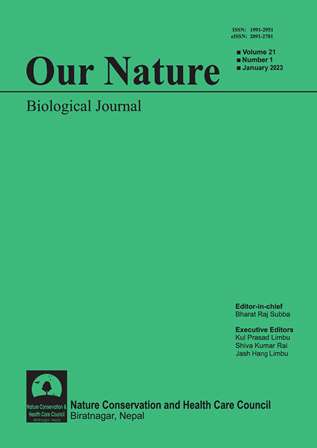Bee flora of Khumaltar agro-ecosystem, Lalitpur, Nepal
DOI:
https://doi.org/10.3126/on.v21i1.50762Keywords:
Abundance, Diversity, Foraging, Moisture, Non-metric multidimensional scaling axisAbstract
This investigation was carried out in Agricultural Research Council (NARC), Khumaltar area, Lalitpur, Nepal to document the seasonal bee flora and diversity patterns. Bees get enough choices to forage in an agro-ecosystem study area. Flowering plants visited by honeybees were observed and documented as per their preferences of foraging, distance away from the bee-hive and seasons. Each plant enlisted as bee-flora if a honeybee visited any flower and rested at least for a while. A total of 168 vascular plant species documented as bee flora in this study. These flora were classified according to season, distance away from the bee-hive, family, genera, species. Simpson and Shannon diversity indices were found higher (0.004 and 3.45) for summer16. Asteraceae family was found to be the most preferred species. Distance of each bee flora was not found significant but season and herbaceous flower were found highly significant contribution. Maximum abundance of Solanum virginianum L. appeared towards the positive end of non-metric multidimensional scaling axis (NMDS2) which was closer to summer16. It signified closer affinity to the beehive and high preferences during summer15. Likewise, the maximum abundance of Vitis vinifera L. towards summer16 and higher positive end of NMDS1 signified favoring more wet loving early blooming species. Relatively higher abundance of species such as Parthenium hysterophorus L., Solanum tuberosum L., Zinnia elegans Jacq., and Solanum melongena L. in the middle of the NMDS axis and spring 16 signified moderate moist loving species. Pattern of bee flora selection, contribution in term of nectar and pollen grain coincided to moisture gradient. This study supports bee farmers for better selection of wild as well as cultivated bee flora for better preference by bees.
Downloads
Downloads
Published
How to Cite
Issue
Section
License
Copyright (c) 2023 Kishna Singh Thagunna, Shreejana Raut, Chitra Bahadur Baniya

This work is licensed under a Creative Commons Attribution-NonCommercial 4.0 International License.
This license enables reusers to distribute, remix, adapt, and build upon the material in any medium or format for noncommercial purposes only, and only so long as attribution is given to the creator.




